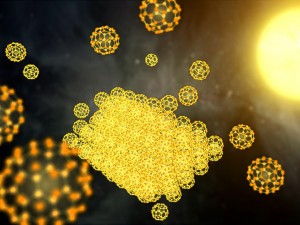
Astronomers using data from NASA’s Spitzer Space Telescope have for the first time discovered buckyballs in a solid form in space. Buckyballs are microscopic carbon spheres formally named buckministerfullerene. They are named after their resemblance to the late architect Buckminster Fuller’s geodesic domes. Prior to this discovery, they have only been found in gas form in space.
The so called Buckyballs are made up of 60 carbon molecules arranged into a hollow sphere, like a soccer ball. Their unusual structure makes them ideal candidates for electrical and chemical applications, including superconducting materials, medicines, water purification and armor.
Scientists using the Spitzer space telescope detected tiny specks of matter, or particles, consisting of stacked Buckyballs. They found the particles around a pair of stars called “XX Ophiuchi”, 6,500 light-years from Earth. They detected enough of these particles to fill the equivalent in volume to 10,000 Mount Everests.
“These buckyballs are stacked together to form a solid, like oranges in a crate”, said Nye Evans of Keele University in England, lead author of a paper appearing in the Monthly Notices of the Royal Astronomical Society. “The particles we detected are miniscule, far smaller than the width of a hair, but each one would contain stacks of millions of buckyballs.”
Buckyballs have previously been discovered on Earth in various forms. They form as a gas from burning candles and exist as solids in certain types of rock, such as the mineral shungite found in Russia, and fulgurite, a glassy rock from Colorado. Buckyballs were detected in space for the first time by the Spitzer telescope in 2010. In all the cases where these molecules have been discovered in space, have been in the form of gas, or at least until now. The recent discovery of solid Buckyballs particles indicates that large quantities of these molecules must be present in some stellar environments in order to link up and form solid particles. It was possible to identify the Buckyballs in a solid form in the recent data because in this form they emit light in a unique way, that differs from the gaseous form.
